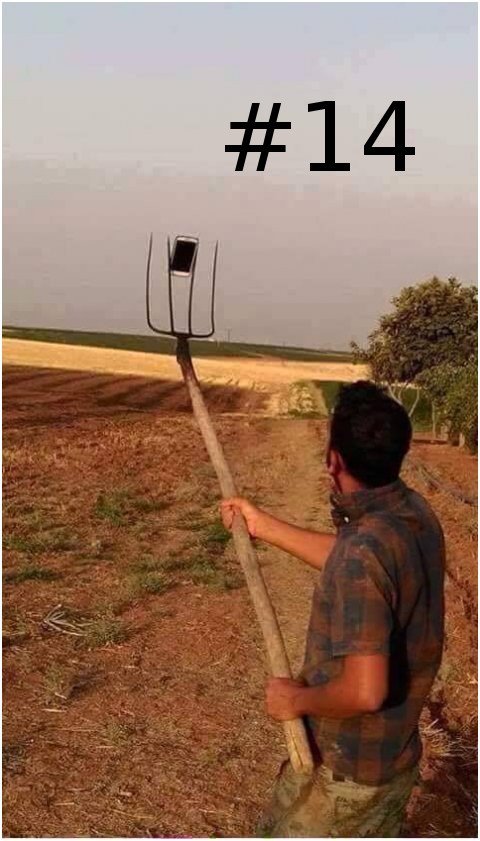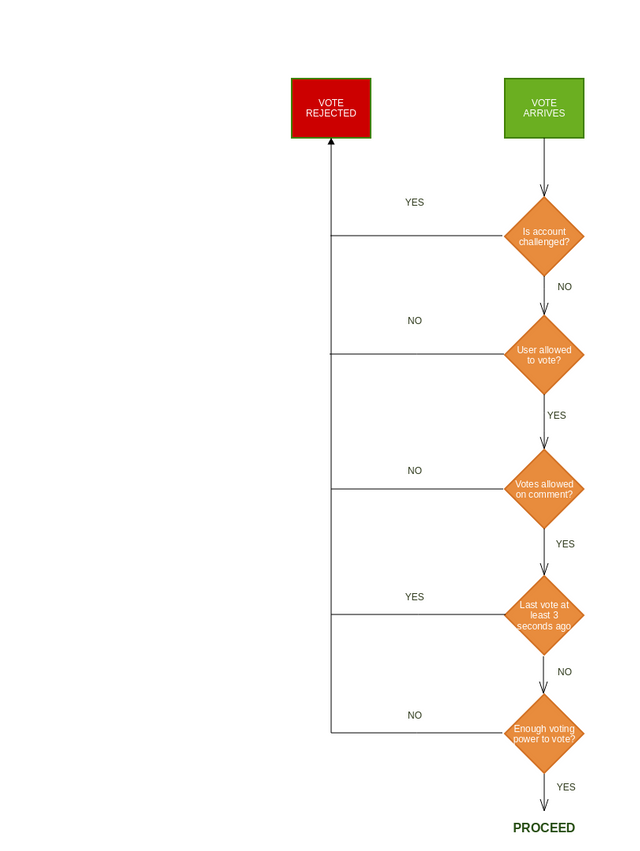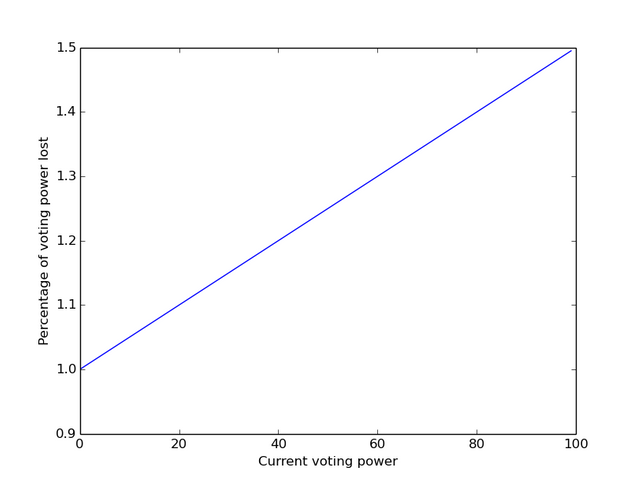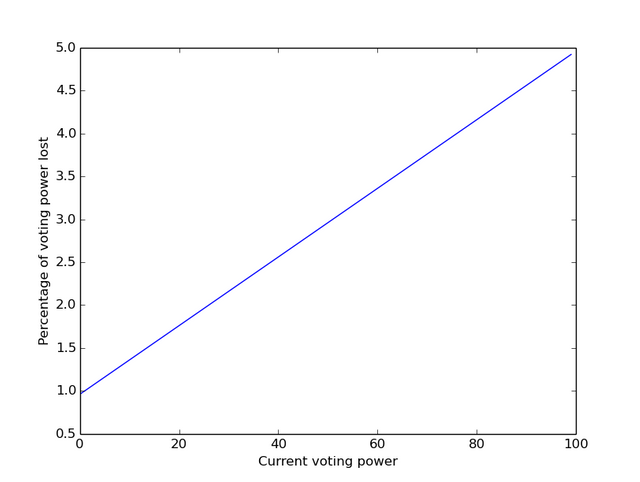I continue to dive into STEEM internals. Today is a day of STEEM hard fork #14 and I will try to present the technical background of one of the main changes that will happen today - the Voting Power regeneration.
My post will be as usual very technical and I will try to provide a summary on what has changed so that the non-technical people should be able to understand it.
In order to be able to understand the change I compared the full source code of the changes that went into hard fork #14. This post specifically targets the voting method before and after the change. Believe it or not but this one single function that processes a vote contains 343 lines including comments. This is a lot. It took me quite some time to understand it and describe it. And by the way, as a side note on hard fork #14 in general: a huge effort went into savings account and escrow payments implementation. I really like it as it also includes tests for the escrow, really good job.
Hard fork #14 will happen today, on 13th September 15:00 GMT.
I somehow wanted the readers to mentally prepare for the technical details and I figured out that the distraction could be the way to rewire the brain. Let's imagine a selfie with the hard fork #14...

I hope you are ready, let's start with constants definitions.
STEEM source code contains a few definitions that are later used for vote impact and the voting power calculations. The important ones for this post are:
STEEMIT_100_PERCENT: 100 %STEEMIT_VOTE_REGENERATION_SECONDS (5 * 60 * 60 * 24): This is 5 days of seconds 5 days * 60 seconds a minute * 60 minutes * 24 hours. 432000 seconds in total.
Additionally there is a global vote_regeneration_per_day property. Until today it was set to 40, after the hard fork it becomes 5.
Vote submission entry checks
Before a vote can be made, vote submission entry checks that a few conditions are met:
- Is the account currently challenged (Hardfork #10), e.g. it is during a recovery process.
- Is the user/account allowed to vote. Apparently some accounts may have can_vote flag set to false and they cannot vote.
- Are votes allowed on the comment.
- Time of the last vote. You can vote every three seconds or less frequently.
- Do you have enough voting power to vote.

Each vote takes a bit of voting power from you
When you start the voting power of your account is set to 100% (STEEMIT_100_PERCENT). BUT with every vote you loose a bit of the power and it start to regenerate with every second after last vote.
The variables are defined in STEEM source code as:
int64_t regenerated_power = (STEEMIT_100_PERCENT * elapsed_seconds) / STEEMIT_VOTE_REGENERATION_SECONDS;
int64_t current_power = std::min( int64_t(voter.voting_power + regenerated_power),
int64_t(STEEMIT_100_PERCENT) );
where:
elapsed_seconds contains number of seconds passed since the last vote submitted from given account.
voter.voting_power contains current voting power of the account during last vote.
regenerated_power says how much power was already regenerated.
The current power cannot exceed 100% of the account total voting power, therefore the maximum is set to 100%.
Therefore if you ever wondered how much power do you regenerate, see the equation below:

Theoretically if your voting power goes to 0, it will take 5 days of not voting to fully recharge it to 100%. I will provide a few values at the end of the post.
Power loss before and after the hardfork #14
Two things have changed with hard fork #14. The vote regeneration per day constant changed from 40 to 5 and the used voting power formula is slightly different.
Please see the source code, full analysis is below.
int64_t max_vote_denom = dgpo.vote_regeneration_per_day * STEEMIT_VOTE_REGENERATION_SECONDS / (60*60*24);
FC_ASSERT( max_vote_denom > 0 );
if( !db().has_hardfork( STEEMIT_HARDFORK_0_14__259 ) )
{
FC_ASSERT( max_vote_denom == 200 ); // TODO: Remove this assert
used_power = (used_power / max_vote_denom)+1;
}
else
{
used_power = (used_power + max_vote_denom - 1) / max_vote_denom;
}
Old algorithm:
Used power (power loss) formula:

let's say your current power is 100 percent, you loose 1,5%
let's say your current power is 90 percent, you loose 1,45%
let's say your current power is 80 percent, you loose 1,4%
This is a linear equation and it is easier to understand when you look at the chart:

New algorithm
Used power (power loss) formula:

let's say your current power is 100 percent, you loose 4,96%
let's say your current power is 90 percent, you loose 4,56%
let's say your current power is 80 percent, you loose 4,16%
let's say your current power is 50 percent, you loose 2,96%

I think comparing the two charts you will get a full understanding about the difference.
Additionally I would like to provide a few values that describe how much does the voting power is regenerated per minute, per hour and per day:
- per minute
0,0138889 % - per hour
0,08333333 % - per day
20 %
Therefore, full recharge from 0 to 100% takes 5 days.
I hope that you enjoyed my post.
DISCLAIMER: THE INFORMATION IS DELIVERED FREE OF CHARGE AND 'AS IS' WITHOUT WARRANTY OF ANY KIND. I HOPE IT IS ACCURATE AND FREE OF ERRORS AND YOU FIND IT USEFUL.
So each vote is regenerating, not the entire account, is that right? You vote, and that vote starts regenerating, while you do other votes?
Downvoting a post can decrease pending rewards and make it less visible. Common reasons:
Submit
No. The entire account is regenerating. It starts regenerating right after you submit a new vote.
Downvoting a post can decrease pending rewards and make it less visible. Common reasons:
Submit
WHat id really like to see is a detailed step by step on how vests * vote power translate into rshares translate into payout.
Downvoting a post can decrease pending rewards and make it less visible. Common reasons:
Submit
I would like to see this as well. Hope you'll consider this idea for a future deep dive @cryptomental
Downvoting a post can decrease pending rewards and make it less visible. Common reasons:
Submit
Thanks. I will consider your advise as I am also interested to find this out.
Downvoting a post can decrease pending rewards and make it less visible. Common reasons:
Submit
I have never seen that voting formula before. Thanks for diving in! How many votes under new and old before I hit zero in a day?(assuming evenly distributed votes)
Downvoting a post can decrease pending rewards and make it less visible. Common reasons:
Submit
Good done job, it is pleasant to read! So to hold "!
Downvoting a post can decrease pending rewards and make it less visible. Common reasons:
Submit
nice post broe
Downvoting a post can decrease pending rewards and make it less visible. Common reasons:
Submit
I have just found out the voting power change was rejected: see https://steemit.com/steem/@steemitblog/steem-0-14-1-released-hardfork-postponed-until-9-20-2016
The old algorithm is still used.
Downvoting a post can decrease pending rewards and make it less visible. Common reasons:
Submit
Nice post and thanks for explaining this! It seems the posting change has been delayed but I wouldn't be surprised if it is implemented at a later date when it can be better explained or maybe even tweaked slightly before it is fully implemented.
Downvoting a post can decrease pending rewards and make it less visible. Common reasons:
Submit
This was a pleasure to read. Ultimately the "golden source" for how Steemit works is, of course, the source code itself. I don't have time to analyze the code myself, so it's great to see posts like this taking a look at it. You've got yourself a new follower!
I'm a bit disappointed the change was postponed, was looking forward to seeing how it would work in practice. But oh well, debate and careful consideration of changes is a good thing (as long as you don't get deadlocked forever like the Bitcoin block size craziness).
Downvoting a post can decrease pending rewards and make it less visible. Common reasons:
Submit